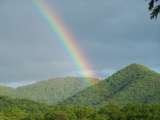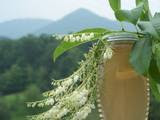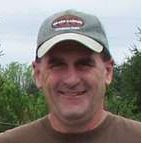
Natural raw honey, much like wine, has very distinct "vintages" depending on year or location of production. Many people go to the local grocery store and buy their honey off the shelf from something like "Susie Beehive" brand and assume that all honey is bland and tastes pretty much the same. Once these people actually taste pure natural raw honey purchased from a local beekeeper, they rarely venture back to the honey section of the local chain grocery store. These people usually start looking for tailgate markets or roadside honey stands to get their fix. There is much that can be said about honey flavors and a few of those points will be explained here.
Big "Susie Beehive" type producers have market demands that must be met. They have to have the quantity to meet demand and a consistent quality in flavor and appearance. Being consistent does not equate with being the best, it just means there is an acceptable quality and it does not vary much. To meet demand, these producers must purchase honey in addition to what they are able to produce, or they may even purchase all their honey because they are just packagers and distributors. This means, honey of the largest volumes and lowest prices are typically chosen. Which in turn means that Clover honey, which is a reasonably good tasting, pure looking and low priced honey makes up the bulk of the honey distributed. Imported honey is also used to fill demand and the sources of these honey purchases are often found in a country that even imported it from another country. All of these honey varieties tend to get blended together to give all honey this generic taste and appearance.
Honey stored properly, will never go bad. This means the honey has to have and keep a moisture content of 18.6 percent or less to prevent fermenting. This particular tolerance is kept to by all honey producers who want to stay in business. Fermented honey is not tasty, unless it is actually processed as "honey wine" or Mead, but that is a very different type of fermentation process. All honey turns to sugar eventually. Some honey tends to turn to sugar quicker than others, but when you blend all types of honey together, you must take this into consideration and heat the honey or "Pasteurize" it. The heating process is not for preserving the honey, it is for slowing the sugar granulation process. If you have a jar of Tulip Poplar honey, it will typically turn to sugar fairly slowly. However, Blackberries bloom during the time that Tulip Poplar does and often the two are mixed by the bees. Blackberry honey turns to sugar very quickly and once that chemical process of crystallization starts,it will continue by turning the Tulip Poplar to sugar at the same time. This blending process, that big producers use, ensures that their honey is probably going to turn to sugar quicker on average than some premium honey varieties will and is the reason for the heating process. The heating process is well over 110 degrees F and actually changes the chemical composition of the honey. The taste suffers as some of the good enzymes the bees put into the honey are destroyed. This process also hobbles the nutritional and healing qualities of the honey. The price paid for a long shelf life due to mass marketing is unacceptable to honey connoisseurs. They happen to know granulation does not hurt honey. It can still be eaten or a warm water bath will convert the granulated honey back to liquid. Care must be taken to keep the heat below 110 degrees F to avoid harming the flavor and nutritional value.
Honeybees can fly 5 miles or more to collect nectar. However, bees do not fly any further than they absolutely have to. This means that honey produced in some areas will have very distinct flavors from one apiary to another. Even 5 miles can produce honey vintages that are very different from the same bloom period. Small producers do not tend to blend honey, so the natural diversity is something that can be experienced and is very delightful to the taste buds. I am a beekeeper and my spring honey is usually very dark in color due to the high volume of Tulip Poplar in my area. My friend keeps bees in another area about 5 miles away and his spring honey is very light in color due to a high volume of Black Locust in his area. These two honey varieties are both premium honeys, but they are very different in taste. Some people prefer the taste of one and some prefer the taste of the other. Neither one is really better than the other and personal preference is key in marketing these different vintages. My Summer honey is usually very light in color due to my area having Sourwood, but my friend has a dark red honey in the summer due to having Sumac in his area. Again, both honey types are excellent honey but personal preference is key in marketing them. If we got together and blended all these honeys together, we would end up with a generic honey much like the big "Susie Beehive" producers and packers.
Different years bring different climate influences and this will also affect the flavor of honey in a specific location from year to year. Last year brought a spring freeze at the exact time Tulip Poplar was blooming in my area. My bees had very little to forage on in the spring and as a result they sought out blooms they would normally not visit so much. My spring honey last year was very light compared to usual. When harvest time came, I discovered the source of this light color. My bees had visited a patch of Mountain Laurel that is in my area because there was nothing else. Mountain Laurel is a close relative to the Sourwood trees that produce one of the most delicious honeys that exists. Mountain Laurel honey is not so delicious. It is actually poisonous with a content of neurotoxins. This honey will cause paralysis or death if enough is eaten, but don't worry because it tastes so bad that nobody could eat that much. This honey was not marketable and was left for the bees because it does not harm them. I take note of various climate and micro-climate conditions during each bloom and educate my customers as to what each variety of honey I produce may contain. I can sell honey at the same table as my friend and we both have unique products that have their own fans. If the honey were to be blended together, there would be no incentive for a customer to buy one over the other. With the diversity of plants in this country, it is a shame to blend all those varieties together, after all variety is the spice of life.
Another issue with honey flavor is when packers or producers try to extend profits by mixing high fructose corn syrup with their honey or feeding cheap sugar to their bees during honey production. This is not really honey at all and the flavor is terrible to a honey lover that has experience with real honey. Selling honey blends is not illegal, if that is clearly stated on the label. Sometimes the economics of the business may tempt a producer to label this as honey to make more money. This practice is rarely found in local producers that have to look their customers in the eye and rely on repeat business from those customers. Honey can take on the taste of smoke or chemicals used in the hive. I use no smoke to remove my honey supers because of this. There is nothing worse than tasting smoky rags when you sit down to enjoy your delicious treat. I know of some beekeepers that use menthol treatments for tracheal mites. This treatment, if administered at the wrong time will alter the taste of honey and give it a minty taste. I use bees that are genetically resistant to tracheal mites and stay away from this treatment. There are no chemicals used in my hives and this adds to that natural flavor that honey is supposed to have.
A new trend in honey marketing is infusion of various flavors into the honey. This practice is not very widely done because of the issues related to introducing anything into a pure product. I do not want that liability nor that extra work. Besides, I figure how could I improve the flavor of such a wonderful natural product. However, premium prices are paid for carefully processed honey with infused flavors. Many of the same marketers that infuse honey also produce small packages of varietal honeys that are purchased from small producers from a wide range of areas. These varietals are often sold in packages of very distinct colors and unique flavors contained in artsy collector bottles. This market is a niche market but very profitable for producers who can tap into those people desiring to experience the various unique flavors of honey produced in exotic areas.
What ever your current preferences in honey are, I would be willing to bet that you would choose a local raw honey over the "Susie Beehive" brand every time once you taste the difference. The key is to try different vintages until you find the one you prefer. There are literally thousands of different honey vintages out there from small beekeepers across the country. I will bet once you find your favorite you will become friends with that beekeeper and if you can not get his honey, you will just do without.





